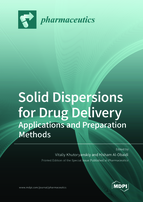Solid Dispersions for Drug Delivery: Applications and Preparation Methods
A special issue of Pharmaceutics (ISSN 1999-4923). This special issue belongs to the section "Physical Pharmacy and Formulation".
Deadline for manuscript submissions: closed (31 March 2021) | Viewed by 42192
Special Issue Editors
Interests: water-soluble polymers; hydrogels; polymer complexes; drug delivery; mucoadhesion; nanomaterials
Special Issues, Collections and Topics in MDPI journals
Interests: amorphous polymeric solid dispersions; pulmonary drug delivery; oral drug delivery; co-crystals; co-amorphous dispersions
Special Issues, Collections and Topics in MDPI journals
Special Issue Information
Dear Colleagues,
Manuscripts are invited for publication in a Special Issue of Pharmaceutics entitled "Solid Dispersions for Drug Delivery: Applications and Preparation Methods". This Special Issue is focused on poorly-soluble drugs formulated as solid dispersions. Formation of solid dispersions, where poorly-soluble active pharmaceutical ingredients are dispersed in a solid carrier, is one of the strategies to improve drug dissolution profiles and to enhance bioavailability. These solid drug dispersions could be formulated with the use of water-soluble or insoluble polymers as well as some small molecular weight materials such as surfactants, sugars, and other drugs. Recent advances in this area of research have shown potential application of co-amorphous and polymeric amorphous solid dispersions to enhance solubility and as well as to deliver combination treatments. Likewise, pharmaceutical co-crystals have attracted significant interest to deliver combination treatments. The drug present in amorphous dispersions typically undergoes rapid dissolution, which may result in its better bioavailability. There are several methods used to prepare solid drug dispersions, which include solvent evaporation, melting, and supercritical fluid technology. Numerous solvent evaporation approaches may also involve the use of spray drying, lyophilization, co-precipitation, electrospraying, electrospinning, etc. There are also several melting approaches such as hot-melt extrusion and melt agglomeration.
Prof. Dr. Vitaliy Khutoryanskiy
Dr. Hisham Al-Obaidi
Guest Editors
Manuscript Submission Information
Manuscripts should be submitted online at www.mdpi.com by registering and logging in to this website. Once you are registered, click here to go to the submission form. Manuscripts can be submitted until the deadline. All submissions that pass pre-check are peer-reviewed. Accepted papers will be published continuously in the journal (as soon as accepted) and will be listed together on the special issue website. Research articles, review articles as well as short communications are invited. For planned papers, a title and short abstract (about 100 words) can be sent to the Editorial Office for announcement on this website.
Submitted manuscripts should not have been published previously, nor be under consideration for publication elsewhere (except conference proceedings papers). All manuscripts are thoroughly refereed through a single-blind peer-review process. A guide for authors and other relevant information for submission of manuscripts is available on the Instructions for Authors page. Pharmaceutics is an international peer-reviewed open access monthly journal published by MDPI.
Please visit the Instructions for Authors page before submitting a manuscript. The Article Processing Charge (APC) for publication in this open access journal is 2900 CHF (Swiss Francs). Submitted papers should be well formatted and use good English. Authors may use MDPI's English editing service prior to publication or during author revisions.
Keywords
- solid dispersions
- poorly-soluble drugs
- amorphous dispersions
- crystallinity
- polymer–drug mixtures
- solid dosage forms
- dissolution properties
- co-crystals








